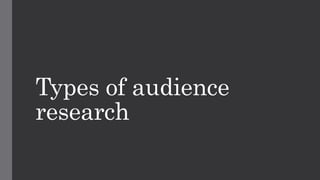Types of audience research
•Download as PPTX, PDF•
1 like•168 views
presentation
Report
Share
Report
Share

More Related Content
What's hot
What's hot (20)
K-to-R Workshop: How to Structure the "Approach" Section (Part 1)

K-to-R Workshop: How to Structure the "Approach" Section (Part 1)
Statistics presentation on primary data and methods for collecting it.

Statistics presentation on primary data and methods for collecting it.
Similar to Types of audience research
Similar to Types of audience research (20)
Using Surveys to Improve Your Library: Part 1 (Sept. 2018)

Using Surveys to Improve Your Library: Part 1 (Sept. 2018)
More from Oliver Buckle
More from Oliver Buckle (11)
Types of audience research
- 1. Types of audience research
- 2. Why do you need to conduct research? • To identify the target audience of the media product. • There is a need to make sure the institution showing the media product already has the right audience and will also attract the right audience. • To ensure the audience reacts in the expected way.
- 3. Primary • This is research done by you and has not been conducted by anyone before. • It usually has a purpose and is original and not copied. • Examples: • Questionnaires. • Interviews. • Observations. • Possibly a relevant conference.
- 4. Secondary • This is research done by someone else and can be used alongside primary research. • It has a purpose but is not original. • Examples: • Newspaper articles • The Internet • Office of National Statistics (ONS) • Broadcasters’ Audience Research Board (BARB)
- 5. Quantitative • This is research that will produce unbiased results that can be measure to generalise a large population. • Results can be shown as a set of numbers and presented in charts or graphs. • Examples: • Audience viewing numbers • Age • Percentages
- 6. Qualitative • This type of research helps to find out people’s opinion on things and why they feel that way. • The responses are personal and therefore can’t be measured. • Examples: • Focus groups • Questionnaires if they have comment boxes.
